Le transfert de votre site WordPress vers un nouveau domaine est une étape importante qui nécessite une bonne offre. Modifier votre nom de domaine peut affecter votre classement SEO, il est donc essentiel de gérer le processus avec soin.
Nous avons mené à bien le processus de changement de domaine à de nombreuses reprises, et nous connaissons donc parfaitement les pièges potentiels et la manière de les éviter.
Bien que des fluctuations temporaires du référencement soient inévitables lors d’une migration de domaine, vous pouvez en réduire l’impact. En adoptant la bonne approche, vous serez en mesure de retrouver rapidement votre trafic de recherche et votre classement.
Dans ce guide, nous allons vous expliquer la bonne façon de déplacer WordPress vers un nouveau domaine sans perdre le référencement.
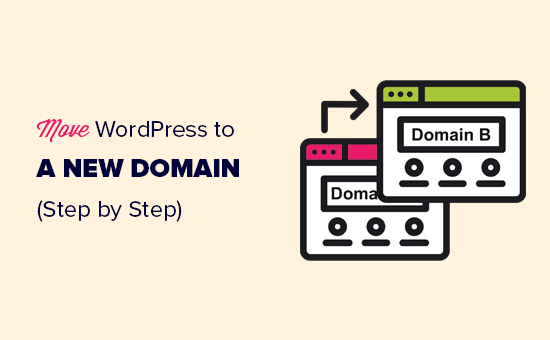
La migration de votre site WordPress vers un nouveau nom de domaine peut être effrayante, mais ce n’est pas une fatalité. Nous sommes là pour vous accompagner à chaque étape du processus.
Vous pouvez cliquer sur l’un des liens ci-dessous pour accéder à une étape particulière de la migration de votre site WordPress vers un nouveau nom de domaine :
- What to Know Before You Change Domains
- Pre-Steps: What You Need to Get Started
- Step 1: Create a Duplicator Package of Your WordPress Site
- Step 2: Create a Database for Your New Domain Name
- Step 3: Unpack WordPress on Your New Domain Name
- Step 4: Set Up Permanent 301 Redirects
- Step 5: Notify Google About Your New Domain
- Notify Your Users About the New Domain Name
- Video Tutorial
Ce qu’il faut savoir avant de modifier un domaine
Avant de commencer, il y a quelques points à connaître.
Le processus de transfert vers un nouveau domaine affectera temporairement votre classement dans les moteurs de recherche, car Google et d’autres moteurs de recherche devront s’adapter aux modifications.
Cela affectera également temporairement votre trafic de recherche. Veuillez garder à l’esprit qu’il s’agit d’un phénomène normal, qui touche tous les sites qui changent de domaine.
Cependant, vous pouvez diminuer considérablement l’impact sur le référencement en suivant ce guide. Nous vous afficherons la bonne façon de déplacer votre site WordPress vers un nouveau nom de domaine, de configurer les redirections 301 appropriées et de rechercher les moteurs de recherche.
Veuillez noter que ce guide ne permet pas de déplacer un site WordPress vers un nouvel hébergeur. Il s’agit d’un changement de nom de domaine uniquement. Bien que le processus soit similaire, il y a quelques étapes supplémentaires. Ces étapes supplémentaires vous aideront à protéger votre classement SEO et votre trafic.
Dernier point, si votre ancien site est sur WordPress.com, alors vous devez suivre les instructions de notre guide sur la façon de passer de WordPress.com à WordPress.org à la place.
Étapes par étapes : Ce dont vous avez besoin pour Premiers pas
Dans ce guide, nous supposons que votre site WordPress est configuré sur oldsite.com et que vous essayez de le migrer vers newsite.com.
Nous partons également du principe que vous disposez déjà d’un compte d’hébergement WordPress et que vous êtes familiarisé avec le panneau de contrôle de votre hébergement web.
Vous devrez également savoir comment utiliser un client FTP comme FileZilla ou comment modifier des fichiers à l’aide de l’application Gestionnaire de fichiers disponible dans le tableau de bord de votre compte hébergeur.
Si vous n’avez pas de fournisseur d’hébergement ou si vous souhaitez en changer, nous vous recommandons d’utiliser Bluehost (idéal pour les petits sites, avec un domaine gratuit) et SiteGround ou WP Engine (idéal pour les sites plus importants ou les boutiques en ligne).
Une fois ces éléments en place, vous êtes prêt à entamer le processus !
Étape par étape : Créer un Duplicator de votre site WordPress
La première chose à faire est de créer une sauvegarde complète de votre site WordPress.
Vous utiliserez ensuite cette sauvegarde pour créer un duplicator de votre site afin de pouvoir configurer correctement les redirections de votre ancien domaine vers le nouveau.
Bien qu’il existe de nombreuses extensions de sauvegarde WordPress, nous utiliserons Duplicator pour ce tutoriel.
Duplicator est la meilleure extension de sauvegarde et de migration WordPress. Nous l’avons utilisé pour migrer d’innombrables sites pour nos propres entreprises ainsi que pour des clients/clientes. Nous avons trouvé qu’il fonctionnait de manière fiable, même pour de très gros sites.
Note : il existe également une version gratuite de Duplicator, que vous pouvez utiliser pour cette migration. Cependant, nous recommandons de passer à une offre payante pour déverrouiller plus de fonctionnalités comme les sauvegardes automatiques dans le cloud, la récupération de sites en 1 clic, des migrations plus faciles, et plus encore.
Commençons par installer et activer le plugin Duplicator sur votre ancien nom de domaine. Pour plus de détails, consultez notre guide étape par étape sur l’installation d’une extension WordPress.
Une fois activé, l’extension ajoutera un élément de menu Duplicator dans votre administration WordPress. Vous devez vous rendre sur la page Duplicator ” Sauvegardes, puis cliquer sur le bouton ” Créer une nouvelle ” pour créer une nouvelle sauvegarde ou copie de votre site WordPress.
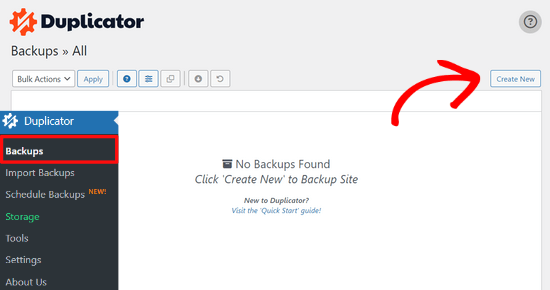
Duplicator va maintenant initialiser le back wizard ; il va automatiquement assigner un nom à ce paquet.
Cliquez sur le bouton “Suivant” pour continuer.

Duplicator va maintenant effectuer quelques tests pour vérifier que tout est bien en ordre. Si l’extension trouve un problème, vous verrez un avertissement avec des instructions.
Si tous les articles sont marqués “Bon”, cliquez sur le bouton “Version”.

L’extension va maintenant commencer à créer un paquet de Duplicator des fichiers de votre site. En fonction de la taille de votre site, ce processus peut prendre quelques minutes.
Une fois l’opération terminée, vous verrez apparaître l’option “Télécharger”. En cliquant dessus, vous afficherez les facultatifs de télécharger les deux fichiers ou de télécharger l’installateur et l’archive (zip) séparément.
Choisissez “Télécharger les deux fichiers” pour les télécharger sur votre ordinateur.

Le fichier Archive est une copie terminée de vos fichiers WordPress. Il comprend vos thèmes WordPress, les réglages des permaliens, les plugins, les téléversements et tout autre fichier défini par les plugins WordPress.
Le programme d’installation est un fichier PHP qui automatise et exécute la migration WordPress en décompressant le fichier d’archive.
Étape par étape : Créer une base de données pour votre nouveau nom de domaine
Avant de déplacer votre site WordPress vers le nouveau domaine, vous aurez besoin d’une nouvelle base de données SQL pour déballer WordPress sur votre nouveau nom de domaine.
Si vous avez déjà créé une base de données, vous pouvez sauter cette étape.
Pour créer une base de données, vous devez vous rendre dans le tableau de bord cPanel de votre compte d’hébergement, faire défiler la page jusqu’à la section “Bases de données”, puis cliquer sur l’icône“Bases de données MySQL“.
Nous allons vous afficher comment le localiser sur Bluehost, mais les instructions de base sont les mêmes et devraient s’appliquer à tous les fournisseurs d’hébergement.
Connectez-vous au tableau de bord de votre compte Bluehost et cliquez sur le bouton “Réglages” sous votre site.
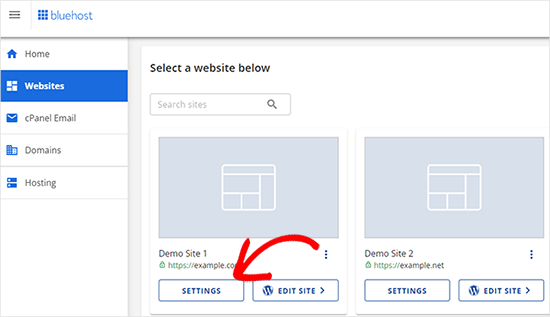
Dans les Réglages de votre site, vous devez passer à l’onglet “Avancé”.
Défilez un peu vers le bas jusqu’à la section cPanel et cliquez sur “Gérer”.
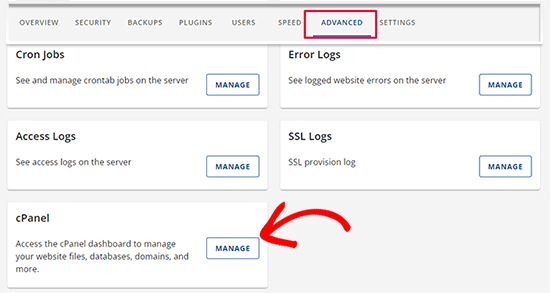
Cela ouvrira le Tableau de bord de cPanel.
Défilez vers le bas jusqu’à la section Bases de données et cliquez sur l’option ‘Bases de données MySQL’.
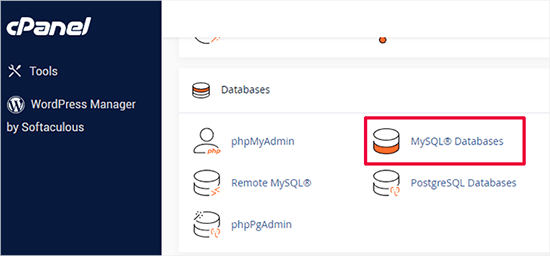
Note : Le panneau de contrôle de votre hébergeur peut être légèrement différent des captures d’écran. Cependant, vous devriez toujours pouvoir trouver une section Bases de données avec une option pour créer une nouvelle base de données.
Il vous suffit de donner un nom à votre base de données et de cliquer sur le bouton “Créer une base de données”.
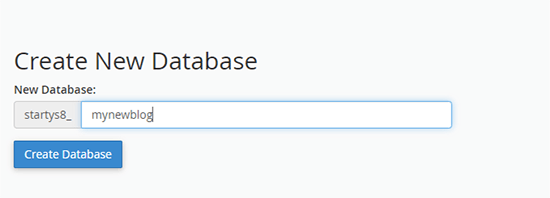
cPanel va maintenant créer une nouvelle base de données pour vous. Ensuite, vous devez défiler vers le bas jusqu’à la section Utilisateurs/utilisatrices MySQL.
Ensuite, indiquez un identifiant et un mot de passe pour votre nouvel utilisateur et cliquez sur le bouton “Créer un utilisateur”. Confirmez la validité de votre identifiant et de votre mot de passe en les notant dans un endroit sûr.
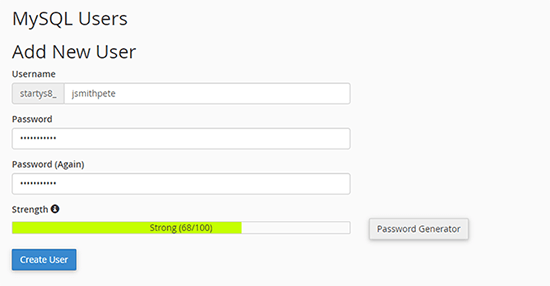
Le nouvel utilisateur que vous venez de créer n’a toujours pas le droit de travailler sur la base de données. Modifions cela.
Défilez vers le bas jusqu’à la section “Ajouter un utilisateur à la base de données”. Tout d’abord, sélectionnez l’utilisateur de la base de données que vous avez créée dans le menu déroulant situé à côté du champ “Utilisateur”. Sélectionnez ensuite la nouvelle base de données que vous venez de sélectionner et cliquez sur le bouton “Ajouter”.
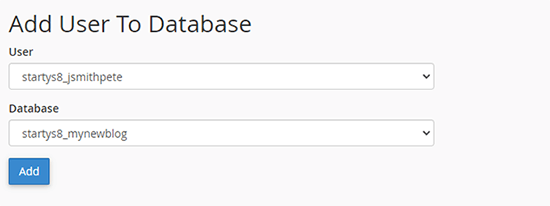
Ensuite, il vous sera demandé de choisir les privilèges de l’utilisateur.
Sélectionnez “Tous les privilèges” et cliquez sur le bouton “Apporter des modifications” pour continuer.
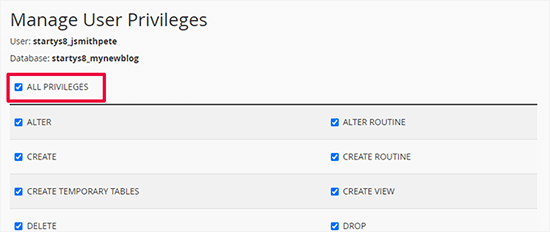
Votre base de données est maintenant prête et peut être utilisée pour déplacer WordPress vers le nouveau nom de domaine.
Confirmez Notez-vous le nom de la base de données, l’identifiant et le mot de passe. Vous aurez besoin de ces informations à l’étape par étape.
Étape par étape : Décompresser WordPress sur votre nouveau nom de domaine
Vous devez maintenant téléverser les fichiers de Duplicator que vous avez téléchargés plus tôt vers votre nouveau nom de domaine.
L’offre de Duplicator comprend également votre installation WordPress. Cela signifie que vous n’avez pas besoin d’installer WordPress sur votre nouveau domaine.
Tout d’abord, connectez-vous à votre nom de domaine à l’aide d’un client FTP. Une fois terminé, assurez-vous que le répertoire racine de votre site est complètement vide.
Ensuite, vous pouvez téléverser les fichiers d’archive et d’installation dans le répertoire racine. Celui-ci est généralement appelé public_html.
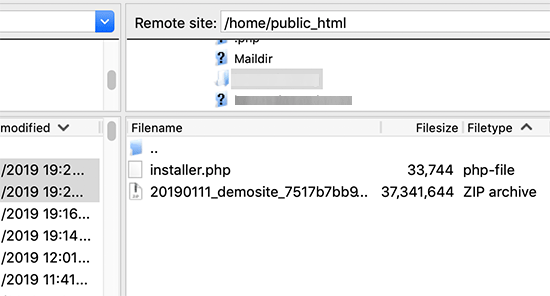
Une fois que les deux fichiers ont fini d’être téléversés, vous êtes maintenant prêt à décompresser WordPress.
Ouvrez un nouvel onglet de navigateur et rendez-vous à l’URL suivante :
http://example.com/installer.php
N’oubliez pas de remplacer exemple.com par votre nouveau nom de domaine. Ceci lancera l’assistant de migration de Duplicator.
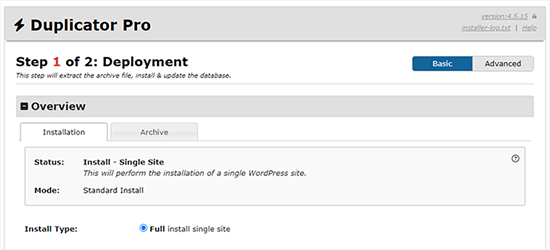
Le programme d’installation recherche le fichier d’archive et sélectionne automatiquement les options qui s’affichent à l’écran.
Défilez un peu vers le bas pour saisir les informations relatives à la base de données que vous avez saisie/saisie à l’étape précédente.
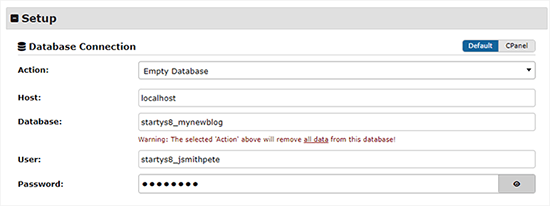
En dessous, Duplicator affichera automatiquement l’URL de votre ancien domaine et de votre nouveau domaine.
Si tout semble correct, cliquez sur le bouton “Valider” pour continuer.
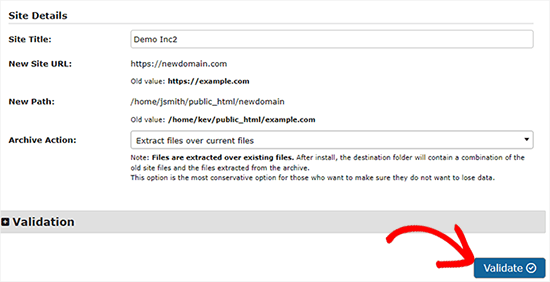
Duplicator va maintenant tenter de se connecter à la base de données en utilisant les informations que vous avez fournies.
En cas de succès, il vous affichera un succès de validation. Dans le cas contraire, il affiche un avertissement indiquant comment corriger le problème.
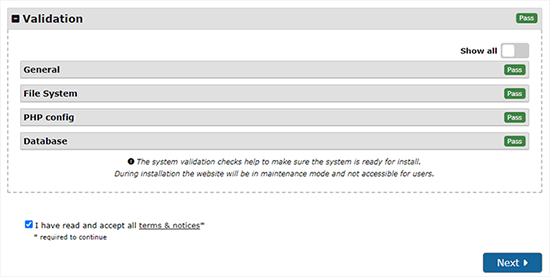
Cliquez sur le bouton “Suivant” pour continuer.
Duplicator va maintenant commencer l’importation de votre site WordPress. Une fois l’importation terminée, vous verrez un message de réussite avec un bouton de connexion à l’administration.
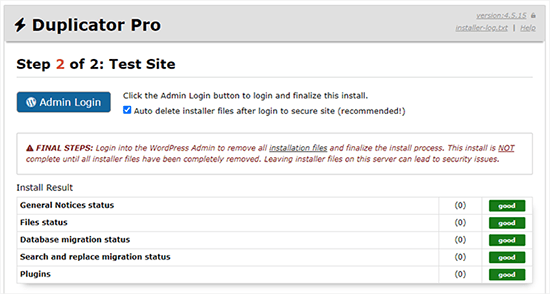
Duplicator mettra automatiquement à jour les URLs vers votre nouveau nom de domaine. Vous pouvez maintenant cliquer sur le bouton ‘Admin Login’ pour terminer les étapes suivantes.
Étape par étape : Configurer des redirections 301 permanentes
L’étape suivante consiste à diriger les utilisateurs/utilisatrices arrivant sur votre ancien nom de domaine vers le nouveau domaine. Pour ce faire, vous devez configurer des redirections 301.
Les redirections 301 sont très importantes pour le référencement et l’expérience compte. Les ajouter vous permettra de rediriger automatiquement les utilisateurs et les moteurs de recherche vers votre nouveau nom de domaine.
En d’autres termes, lorsque quelqu’un arrive sur une publication ou une page de votre ancien domaine, il sera automatiquement redirigé vers la même publication ou page sur votre nouveau domaine au lieu de voir une erreur 404.
Pour maintenir vos redirections en place, vous devrez garder votre ancienne installation WordPress active afin qu’elle puisse continuer à rediriger vers la nouvelle que vous venez de créer.
Il y a deux façons de configurer les redirections. La première méthode est facile et ne nécessite que quelques clics. La deuxième méthode nécessite de modifier les fichiers manuellement.
Méthode 1 : Configurer des redirections 301 avec All in One SEO
Pour cette méthode, vous aurez besoin du plugin All in One SEO (AIOSEO). C’est la meilleure extension WordPress SEO sur le marché et vous permet d’optimiser facilement votre site WordPress pour le référencement.
Tout d’abord, vous devez installer et activer l’extension All in One SEO sur votre ancien domaine. Pour plus de détails, consultez notre guide étape par étape sur l’installation d’une extension WordPress.
Note: Vous aurez besoin au moins de la version Pro du module pour accéder au module de gestion des redirections. Vous pouvez également configurer AIOSEO sur votre nouveau site WordPress pour booster encore plus votre classement dans les moteurs de recherche et votre trafic.
Lors de l’activation sur votre ancien domaine, vous devez visiter la page All in One SEO ” Redirects et cliquer sur le bouton ‘Activer les redirections’.
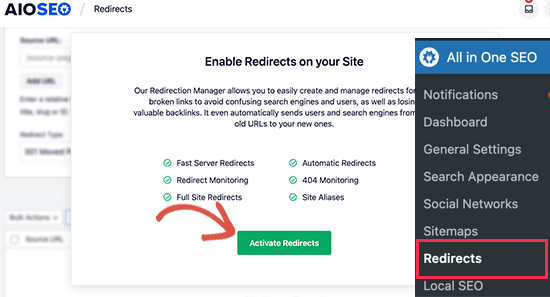
Ensuite, vous devez passer à l’onglet “Redirection complète du site” et activer le permutateur “Relocaliser le site”.
Ensuite, vous devez saisir votre nouveau nom de domaine à côté de l’option “Relocaliser vers le domaine”.
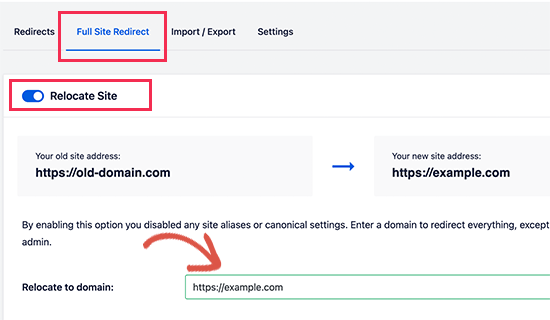
N’oubliez pas de cliquer sur le bouton “Enregistrer les modifications” pour stocker vos réglages.
Réglages 2 : Configurer manuellement les redirections vers le nouveau domaine
Cette méthode nécessite de modifier le fichier WordPress .htaccess sur votre ancien nom de domaine.
Tout d’abord, vous devez vous connecter à votre ancien site à l’aide du protocole FTP et modifier le fichier .htaccess.
Celui-ci sera situé dans le même répertoire que votre dossier wp-includes ou wp-admin. Ouvrez le fichier .htaccess et collez les lignes de code suivantes tout en haut :
1 2 3 | #Options +FollowSymLinksRewriteEngine onUnchanged: RewriteRule ^(.*)$ http://www.newsite.com/$1 [R=301,L] |
Confirmez-vous que vous remplacez nouvelleite .com par votre nouveau domaine dans le code ci-dessus.
Une fois que vous avez appliqué ces modifications, visitez votre ancien nom de domaine. Il devrait vous rediriger automatiquement vers le nouveau domaine.
Si ce n’est pas le cas, cela signifie que la redirection n’est pas correctement configurée et que votre serveur ne supporte probablement pas les règles de redirection. Vous devez contacter l’équipe de support de votre entreprise d’hébergeur pour activer RewriteEngine.
Étape par étape : Informer Google de votre nouveau domaine
Maintenant que vous avez déplacé WordPress vers un nouveau nom de domaine et mis en place des modifications, il est temps d’informer Google de votre modification d’adresse. Cela aidera Google à trouver rapidement le domaine de votre nouveau site et à commencer à l’afficher dans les résultats de recherche.
Tout d’abord, vous devez vous assurer que votre nouveau et votre ancien domaine sont ajoutés à la Google Search Console en tant que deux propriétés différentes. Reportez-vous à l’étape par étape de notre guide Google Search Console pour obtenir des instructions.
Ensuite, vous devez sélectionner l’ancien nom de domaine comme propriété active dans le tableau de bord de votre compte Google Search Console.
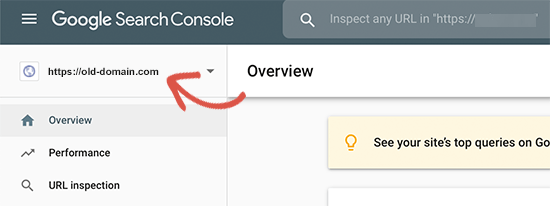
Ensuite, cliquez sur le menu Réglages dans la colonne de gauche.
Vous pouvez maintenant cliquer sur l’outil “Modification d’adresse”.
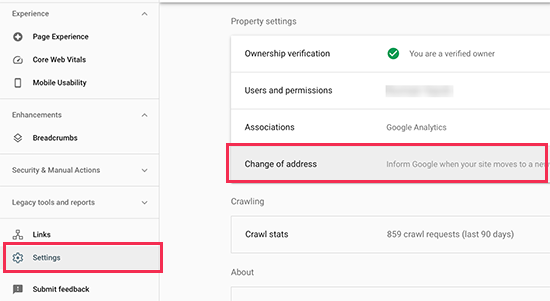
Vous devez maintenant sélectionner votre nouveau domaine dans la section Mettre à jour Google.
Cliquez ensuite sur le bouton “Valider et mettre à jour”.
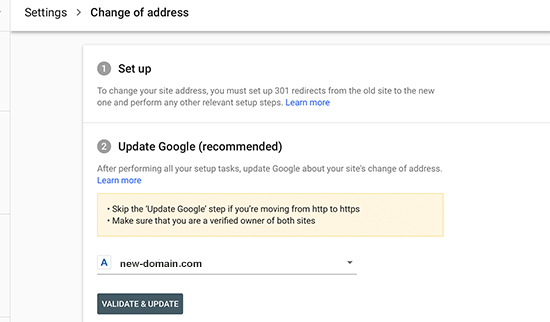
C’est tout. Google va maintenant valider que votre ancien domaine redirige vers le nouveau domaine et enregistrer vos modifications.
Sur l’écran suivant, Google Search Console affiche un assistant étape par étape pour envoyer votre demande de modification d’adresse.
Informer vos utilisateurs/utilisatrices du nouveau nom de domaine
Pendant que les redirections 301 font leur travail, il est toujours bon de faire une annonce publique de la migration.
Pour ce faire, il vous suffit de rédiger une publication de blog sur votre nouveau site et de la partager sur vos comptes de réseaux sociaux.
Si vous avez une newsletter par e-mail ou des abonnés/abonnés aux notifications push, alors vous devriez également leur envoyer une annonce.
Cela peut être utile à bien des égards.
Tout d’abord, vos utilisateurs/utilisatrices sont plus susceptibles de se souvenir du nouveau domaine une fois qu’ils en ont pris connaissance.
Deuxièmement, vous pouvez demander à vos utilisateurs/utilisatrices de vous faire savoir s’ils voient des bogues. Vous ne pouvez pas tester votre site dans tous les types de navigateurs ou d’environnements, c’est pourquoi il est toujours utile d’avoir un regard neuf.
Tutoriel vidéo
Ressources en prime
Les articles et tutoriels abonnés vous aideront à suivre et à retrouver votre classement SEO après avoir migré vers un nouveau nom de domaine :
- La liste de contrôle ultime pour la migration SEO de WordPress (pour les débutants)
- Comment vérifier si les publications de votre blog WordPress sont classées pour les bons mots-clés ?
- Comment suivre les internautes sur votre site WordPress
- Astuces pour optimiser vos publications de blog pour le référencement comme un pro (liste de contrôle)
Nous espérons que ce tutoriel vous a aidé à déplacer votre site WordPress vers un nouveau nom de domaine. Vous pouvez également consulter notre guide sur la façon d’obtenir un domaine e-mail gratuit ou suivre les étapes de notre guide complet sur le référencement WordPress.
Si vous avez aimé cet article, veuillez alors vous abonner à notre chaîne YouTube pour obtenir des tutoriels vidéo sur WordPress. Vous pouvez également nous trouver sur Twitter et Facebook.





Maya
Should I keep all files on my old domain (the whole WordPress installation) or it is enough just to have .htaccess with 301 redirect?
James
Hi guys,
The 301 redirect doest redirect the pages, what can I do?
Logan Cale
I had a similar problem with the .htaccess redirect only redirecting the domain (front page), and not the sub-pages, but when I also added the line below in .htaccess file, all sub-pages were then redirected if they had the same exact name.
Redirect 301 / https://newdomain.com/Euan
Hi Logan. You, my friend, are a legend. Several hours of searching as I had the same problem – the front page was redirecting but nothing else. I added this line of code and it is now sorted. Thank you!
Kim Saxton
Hi,
This has been really useful thank you so much, but I am now a bit stuck.
I got up to step 2 and ran the deployment button on the installer php site. Then I went away for a week, I made some formatting changes to my newsite (just colour, logo not any changes with pages).
I now want to update my URLs on the installer update page. But I can no longer access it. It comes up with a 404 error page cannot be found. See
My old site is
Can you advise?
Thanks
Kim
Sorin Vizireanu
Excellent post, thank you.
Ashley
I have a question. We are a business and we just had an ecommerce shop built on our regular business website.
We know would like to take just the shop and put that on a separate domain.
How would that process work?
WPBeginner Support
Hi Ashley,
You will have to set up redirects in a way that only your shop URLs are redirected to the new domain name.
Admin
Peter Ishola
How do i download the package files? Do i have to download it from my wordress admin or from my cpanel because i cannot find any download link on my wordpress admin.
Thanks
Manpreet Singh Rehsi
Hi,
Thanks, for such a detailed article. This really helped to moving one of my blog to a new domain last month.
Right now my blog is undergoing a move in google webmaster. Now I want to implement SSL on my new domain.
Should I make a move to implement the HTTPS or wait for move to be completed in google webmasters.
Will SEO will take a negative impact if I implement https now.
Ahmed Rifshaan
Hello,
Regarding 301 Redirect you said, we should edit old .htaccess file…
What if we dont change host, only changing the domain name?
My site doesnt move, only the domain is changing..
In that case what should i do?
Jay Soriano
There is one part that could use a little bit of clarification, and I read through most of the comments and couldn’t find an answer. With regards to the 301 redirect, in the post you mention:
“In other words, whenever someone lands on one of your old posts or pages, then they will be automatically redirected to your new site.”
If they land on an old post (olddomain.com/post), will they be redirected to the post on the new domain (newdomain.com/post), or simply to the root domain (newdomain.com)?
WPBeginner Support
They will be redirected to the post.
Admin
Claudio
How long is it safe continue to keep the older domain and website, after you redirect to new one?
Jo
Hi, I don’t know if you can help me. I purchased a new domain name from my host. I followed the instructions in this article. When I logged into my FTP client I did so under my old domain name first of all (I think I thought I had to) and then on the ‘new session’ tab I logged in under my new domain name. Under my new domain appeared to be all the same files as my old domain.
The article said to make sure the root file was empty so I deleted all the files from the new domain name in the FTP client and uploaded the installer.php file and archive zip file.
When it comes to launching the installer.php file in my web browser it comes up with a 404 error and now I’m stuck. Do you have any advice?
Thanks!
Jo
UPDATE: I finally managed to get onto the Duplicator and have added a new MySQL database and run the tests. However, now when I try to log in to update the permalinks using my same username and password it says it doesn’t recognise my details. I tried ‘forgot password’ but it didn’t recognise my email.
It’s also saying there is HTTP 500 error on my new (and old) domain names.
Any advice would be great, please.
Thanks!
Amirhossein
Hi
I have a theme installed and active on my wp site right now:
1. It has a custom post type called “video_type”.
2. The URL pattern of all video_type post are like this: mysite.com/video_type/the-video-name-url. It means the /video_type/ is always there in all video post URLs.
3. There is another custom post type called “genre”. Which acts as “categories” but only for video_type posts.
4. The URL pattern for “genres” is like this: mysite.com/genre/the-genre-name-url. It means the /genre/ is always there in all genre URLs. And they contain video post lists.
5. All of my videos and genres are indexed in google and they mostly rank very well. Some of them rank 1-3.
Now I want to change the theme. The new theme does not recognize “video_type” and “genre”. And I don’t want theme to be recognized.
I have decided to change the “video_type” to “post” with “Post Type Switcher” plugin. But after changing type:
1.”genre” is no longer available for posts (Only categories are available).
2. And I cannot change the “genre” post type to “categories” with that Plugin.
3. mysite.com/genre/the-genre-name-url genres will be pages with no content.
4. The URL of the video posts changes. (there will be no “video_type” in the URL and I don’t want it to be BUT SEO?)
Here are my goals:
1. change “genre” to “categories”.
2. change the “genre” URLs.
3. change the “video_type” to “post”.
4. change “video_type” URLs.
5. I also want to Prune and Optimize my current categories. (Remove, Add and Edit some of theme).
So I want to know what is the best practice here for “Not having any negative SEO”? And how to achieve these goals anyway?
WPBeginner Support
You will have to set up redirects. You can use Regex to detect URL patterns and redirect them accordingly. Please see our guide on how to setup redirects in WordPress
Admin
Michel Fortin
If I have two different websites and we want to transfer one of them to the other one. The thing is that we want to close the first website now but transfer the content later, what would be the best practice on the redirect side?
Michael Barth
Thanks for that article, but my problem is a bit more complex. I have a 301 redirect for a domain name I use to a hoster for templates websites. I now have a new hoster and a WordPress site there. I will change my 301 to now redirect to my new wordpress site. I have no access to the htaccess file on the “old” hoster, and need to cancel the contract anyway.
Any idea how to best do that .
Thank you.
Sujeet Thakur
Thanks a lot from bottom of my heart. My all problem are solved to read your blog. thanks again ..!
saeed
I am looking to safely migrate wordpress website to new html website without losing the google ranking. please contact
Sant
Hi SAEED,
Did you move your domain WordPress to HTML?
I am planning my website to move from WordPress to HTML, I want to know is this effects any SEO?
Please suggest on this?
Thanks in advance!
Alessandro Bertelli
Hi.
I am moving a site from a dummy/test subdomain to the definitive domain (something like moving from temporary.example.com to example.com.)
While i kept the site mostly offline during developement i forgot for a brief period the site open.
This was enough for googlebot to snuck in and i find many pages indexed already, with the addresses starting with temporary.example.com/whatever instead of example.com/whatever.
Now i am going to put online the site on the real address and i fear that the fact that the same pages are indexed twice will damage SEO.
I have no previous traffic or seo score to save from the test subdomain, can i just delete the old site?
WPBeginner Support
Hi Alessandro,
Once your site is live, you can set up a 301 redirect from temporary url to your current URL. Take a look at our guide on how to set up redirects in WordPress.
Admin
Alessandro Bertelli
Hi, thanks for the answer.
As i said the site i want to move has no SEO to save… i am only worried of google thinking less of it because of the (temp and no more existing) duplicate pages.
The redirect would be just for the search bots.
Is a 301 redirect a better solution instead of just removing the site?
WPBeginner Support
Even if you remove the site, you would still need to tell search engines where it has gone. This way search engines won’t penalize the new and live site for duplicate content. 301 is the HTTP code which tells search engines that the content they are trying to access has moved to this new location.
Jeffrey Collins
I simply made my site secure, changing the url. I have used a 301 redirect from the root, will that redirect all pages? This is a wordpress site.
Ataul Ghani
i just move the old domain to new domain. The process was something like that, just install wp to new domain and import all files and database on it. Then old domain made an permanent redirection to new domain. I shared sitemap to web master and other search engine also. Also old domain web master admin i said to change domain name by using domain name changer tools in web master. But still not remove any files from old domain directory, so is that will be problem for me??? lease let me know.
Thank You!
Rabin Mahmud
Hello,
I have a old site but I want to redirect that to new domain without losting my any permanent SEO juice. But I need to know that should I redirect all the urls of old domain to new site similar urls or I just need to redirect the domain Name.
It’s very important for me to know.
Thanks
Ravi
I have properly 301 redirected my site to new domain. Do i need to add sitemap of new domain after redirection and address change at webmaster tools? Also my site traffic has significantly gone down. Around 70% drop within 10 days. Is this normal? And how much time will it take to go up.
Please answer and help.
Sandy Gogoriya
I want ask you one question. I have two website. One is old and one is new. so i want transfer my old website 5 post to my new website. Like on my old website have 5 smartphones post and i want publish these post on my new domain with old website content that already publish so what i do now.
Ernest
Hi, thank you for the great explanation! I am wondering, Does putting the code in the htacces file mean That i don’t need to redirect all individual links? I was looking at the plug-in 301 simple redirects, but there I need to fill in every single link.
My old site is live for a while so I would like to keep the page values for Google.
BR!
Josh
What should be done with the content on the original site after the duplicate content, all 301 redirects. and change of address in the search console are complete? Is it best to remove the original content? Any chance it will get penalized as duplicate content?
WPBeginner Support
You don’t need to have the content live to set up a redirect from one WordPress install to another. But if you do, then that’s alright too, because your users and search engines won’t stay on the old content and they will be redirected. If your content was hosted on a platform like WordPress.com or Blogger, then we would recommend you to keep your content in private mode for at least six months.
Admin
David Budimir
Hi there,
We’re migrating our blog from a blog.domain.com to domin.com/blog. Out site is currently live on our main domain, will migrate the blog to the same database mean we need to access it differently?
In other words, will it affect our process for creating blog content in the wordpress dashboard?
Thanks!
WPBeginner Support
No, it wouldn’t affect blog creation. However, you may need to update URLs in database to make sure that they are pointing to the new location.
Admin
sudhir
Thanks WPBEGINNER team for writing such an awesome and helpful article. I have followed all steps carefully and migrated my old domain to new domain, everything is working fine except one, that is; my old home url is not redirecting to new one while all internal pages are redirectd to new pages.
Michall Helmbæk
THX for the best article in a long time that really works!
suhan ahmed
I want to move my https enabled site to a new https enabled domain for rebranding purpose. For example,
From https olddomain.com
To https newdomain.com
To put 301 code to the .htaccess file of old domain. I need to keep the installation of old domain untouched.
The problem is here I will need two SSLs, IPs (in some cases, servers) which is a bit costly for me.
What can be the best solution here?
Or
Can I follow the below mention method!!!
If I switch back to my https olddomain TO http olddomain
and then from olddomain TO newdomain.
Will I lose ranking or be penalized by Google here?
roshan christy
Hi.,
This is article exactly something I was looking today but a bit confused now. My blog was hacked and was injected with a conditional redirect malware. Since my hosting provider allows two managed WordPress installs, I migrated the ‘uploads’ folder and database to the other one. Now I wish to change the domain name too as the current one have many external spam websites indexed by Google as subdomains. I want to keep the old domain name but delete the old site with malwares. But this article is suggesting to keep the old website with the .htaccess edit. Can I use the old domain along with new one by deleting the old website?
Leonardo
Nice, thanks. It was very helpfull!
New
Hello
If I just move my content wordpress to newsite as the same domain I am using, Is it neccessary to do 301 redirect?
Rocky
In new Google Webmaster Tools there is not any option of changes of address option. please tell me now how can i notify google.
Joey Espinoza
Great tutorial, thank you
Aron Jay
Does this work to specific posts or it will automatically redirect everything to the new domain.
I’m planning to move some of my posts to another domain, not entirely the whole blog. Thanks!
Michael J.
Hi WPBeginner – Your step-by-step guide is great…but, I just have a quick question to confirm before moving forward with changing my wordpress domain…
Unfortunately, the Duplicator Plugin is not working for me….so, can I manually copy & paste a backup of the my ‘old’ site into a new directory for the ‘new domain?…and follow the rest of the steps above.
Also, I am using the same hosting for my old & new domain — So, do I create a new directory folder for the ‘new’ domain — and keep the ‘old’ domain folder on my hosting?…basically, my hosting would have (2) site folders?…the old & new.
I’ve read various places say I only need to point to the new domain on wordpress…however, im extremely concerned with losing my SEO rankings from my old domain, so i’ve been kindda hesitant with the process..
Any reply would be greatly appreciated…Thanks!
WPBeginner Support
You should create a new directory on your hosting server. Download all your WordPress files and then upload them to the new directory. You will also need to export your old database. Create a new database in your hosting cPanel. Open phpmyAdmin and then import your old database. Rest of the steps would be the same.
Admin
Michael J.
Thanks for the reply!…I will make sure to follow your detailed instructions.
Bunty Pundir
Hey,
I created the package with Duplicator plugin and also, uploaded installer and archive package to new domain but unable to launch installer.php using example.com/installer.php and the browser showing server not found!
Help please:-(
Mihira
Success!
I was afraid to take up transfer of my domain from .in to .com since 6 months or more. This guide is so easy to follow, I was up and running in the new domain within an hour. Thank you wpbeginner for this helpful post.
One question though… My old domain didnt have such a great SEO characteristics to pass on. I no more want to use that old domain. Can I set a 301 direct in .htaccess of old site and leave it WITHOUT RENEWING THE DOMAIN WHEN IT EXPIRES OVER THE PERIOD?
Please let me know!
WPBeginner Support
Yes, you can do that. However, it is recommended that you keep the domain up with redirects for at least 90 days. You should also submit a change of address request to Google from Google webmaster tools.
Admin
Edward
Another question: if I delete all the old images in the old site folder, google webmaster will tell me there`s 100,000 dead paths and I will have to delete them one by one. Should I just leave the image folder untouched? I don`t want to see all those missing file notifications in my webmasters account.
Edward
I will be keeping the same .com domain but the images in the old pages will have a different name. ( e.g. from 0429_lg.jpg to ocean_home.lg.jpg so I am changing the name of 10 images ( now will have twice that number ) on each listing with different name. Does that affect SEO? I guess having the new seo friendly name in images might even be better.
Shreya
Hi there !
Recently I tried migrating my wp website to new domain ( shared server) but the Duplicator plugin didnt work . Then I opted for manual migration, everything is working well but I can’t aceess my wp-login.php page for my new website in new domain.
Can you please help me on this matter ? I shall provide more details of both my websites too .
Thanks .
Zane
Thank you! Followed instructions and worked perfectly.
Duane Reeve
I’m busy migrating a clients domain and a relatively old post on MOZ.com states one should redirect each URL independently. While MOZ is an industry leader in SEO, I’m questioning this since their post is from 2009. Is this overkill or the best way to proceed?
WPBeginner Support
If you have a static site with less than 10 pages, then this makes sense. But if you are moving a site with hundereds of posts, then it will be quite difficult to setup each redirect manually.
Admin
Duane Reeve
Thank You – Clients WordPress site had 36 pages/posts, which I redirecting manually using the Redirect Plugin. I then updated the sitemap and re-submitted this to both Google & Bing.
I didn’t redirect image or tag URLs.
After 48-hours, of doing the page/post redirects, I submitted the URL Address Change to both Google and Bing Webmaster Tools. I decided to give both Search Engine time to detect the Page/Post Redirects and will do a Domain Redirect (using .htaccess file) at the end of the week.
Based on my Google Analytics & Google Webmaster Tools for the new Domain I’m pretty happy with the results so far.
Dario Fumagalli
What Moz says is 100% safe, whereas what WPBeginner says has one big issue: the old website sitemap.
Adding a sitewide 301, **also** redirects calls to the old sitemaps, whereas Google needs it to stay in there to prove both the old sitemap and the new one are same or similar.
Therefore, if you do it the Moz way you are ultra-safe, if you do it the WPBeginner way you need to add exceptions to exclude all the old sitemap index (if any) and sitemap(s) until Google understand both refer to the same ownership.
Mark D
Hi, I don’t have an FTP provider. When I loaded one, it lit up my anti-virus software. I am trying to create a website for a friend based on my site. Is there an easy, non-FTP solution, to clone to my friend’s domain. Once that’s there, I can then update with her content.
Thanks,
Lynn Dye
Is it a good idea to delete my old site (except for the .htaccess file), on my old host so I don’t have 2 exact sites on two hosts?
Nelson
Can your created a tutorial moving a wordpress site to a new doman wihout a plugin, like for example moving subcategory to the main site or subdoman to the mina site wihtout a plugin.
Satish
Hi, very useful article but i have a doubt . What if i download my backup manually by making zip, also download the database from Mysql from cpanel.
And then manually upload to the new host filemanager. Do i need to change the URL in database from old-domain.com to new-domain.com before uploading the database to mysql?
Hope you understand, what i’m saying!
Daniel Ruyter
Question on the redirects – I’m currently running two sites (two TLD’s, two hosts) and would like to consolidate into a single site, retiring the “old” site host. Can I redirect the “old” TLD to the new at the DNS and then add rewrite rules to my “new” site’s .htaccess for the migrated posts?
Thank you!
-Daniel
Lynn Dye
This has worked well – question on the redirect. I changed my domain AND hosting. So I’d like to close out my old hosting account.
How long should I have the redirect for my old domain? I’m planning on keeping the old domain for some time.
Would a forward on the old domain accomplish the same thing as the 301 redirect?
Daniel Ruyter
I’d keep the old domain name redirected as long as you’re able.
Lynn Dye
If I used BackupBuddy to move my site to a new domain and then followed the directions to do the 301 redirect, shouldn’t I get the same result
What about typing in the old and new url that Duplicator has you do – how is that step done with BackupBuddy?
Thanks for an interesting post.
WPBeginner Support
Yes, you can use BackupBuddy too.
Admin
Katie Steckly
So if I transfer my site with these exact instructions, with Google analytics automatically keep working? Or do I need to re-install the tracking code on my new site, and take it off the old one?
Travis Pflanz
Google Analytics will still work as long as you use the same UA code as before. That said, it may be worthwhile to setup a new view in your Google Analytics dashboard after you make the change